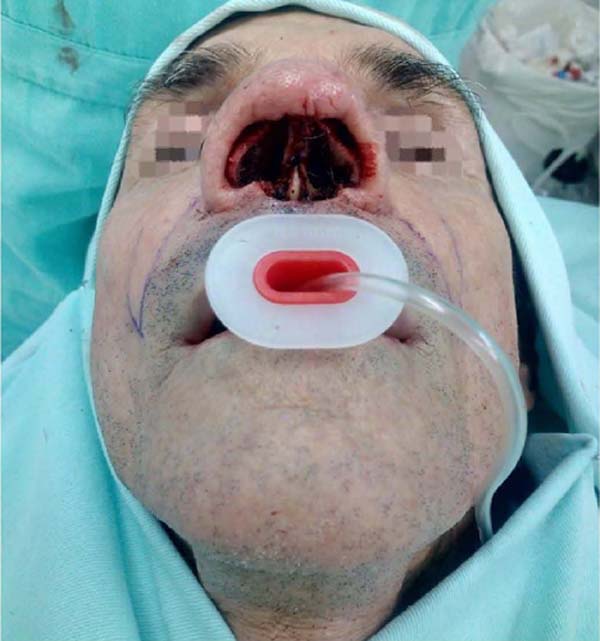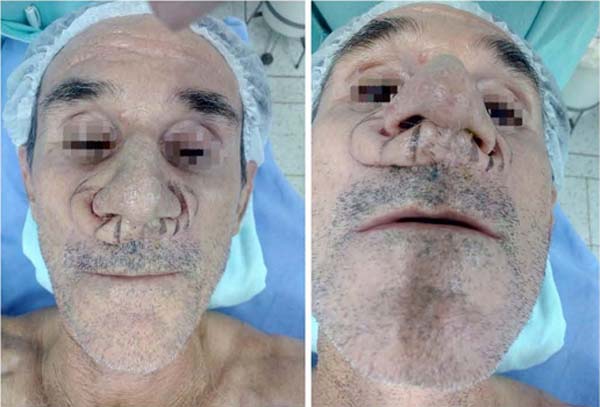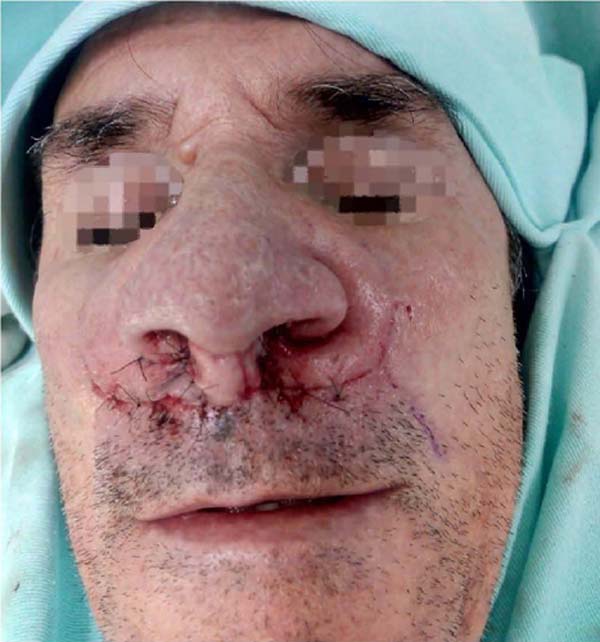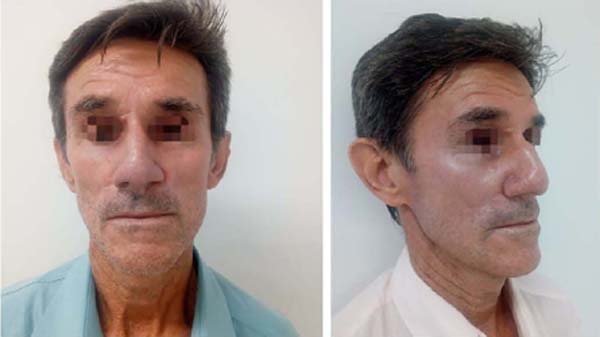

Case Report - Year 2023 - Volume 38 -
Reconstruction of the nasal columella using bilateral nasolabial flaps: case report
Reconstrução da columela nasal com utilização de retalhos nasolabiais bilaterais: relato de caso
ABSTRACT
Introduction: The columella is an important subunit of the nose, essential for nasal architecture and facial aesthetics. The total reconstruction of the nasal columella becomes a great challenge after repairing trauma, carcinomas, and necrosis in this region. There are descriptions in the literature of numerous reconstruction techniques using different flaps, such as a frontal region flap, an infraclavicular region flap, and a unilateral and bilateral nasolabial flap.
Case Report: A total reconstruction of the nasal columella after resection of basal cell carcinoma (BCC) using a bilateral nasolabial flap is reported.
Conclusion: The technique proved effective for correcting the complex defect after BCC resection, with technical ease for resolution and good aesthetic and functional results.
Keywords: Skin neoplasms; Carcinoma, basal cell; Surgical flaps; Nasal surgical procedures; Reconstructive surgical procedures
RESUMO
Introdução: A columela é uma importante subunidade do nariz, sendo essencial para a arquitetura nasal e estética facial. A reconstrução total da columela nasal torna-se, portanto, um grande desafio após reparação de traumas, carcinomas e necroses nesta região. Há na literatura a descrição de inúmeras técnicas de reconstrução com uso de diferentes retalhos, como retalho da região frontal, retalho da região infraclavicular, retalho nasolabial unilateral e bilateral.
Relato de Caso: Reporta-se uma reconstrução total da columela nasal pós-ressecção de carcinoma basocelular (CBC) utilizando retalho nasolabial bilateral.
Conclusão: A técnica utilizada mostrou-se eficaz para correção do defeito complexo pós-ressecção de CBC, apresentando facilidade técnica para resolução e bom resultado estético-funcional.
Palavras-chave: Neoplasias cutâneas; Carcinoma basocelular; Retalhos cirúrgicos; Procedimentos cirúrgicos nasais; Procedimentos cirúrgicos reconstrutivos
INTRODUCTION
The reconstruction of a total defect in the nasal columella is a challenge for surgeons, and it is possible to perform it in one or several stages1,2. Among the alternatives for repairing the nasal columella, we can opt for local flaps, including the bilateral nasolabial flap3.
The literature reports numerous other reconstructions: the Indian flap4, the “U”-shaped frontal muscle flap2,5, and the unilateral nasolabial flap6 for repairing the nasal columella.
Seeking a surgical option after the excision of an extensive tumor (basal cell carcinoma - BCC) in the columella with oncological safety margins, we came across the bilateral nasolabial flap3, the object of the present case report, which proved to be a non-aggressive solution, with rapid resolution and performed with local anesthesia and sedation.
OBJECTIVE
This work aims to describe the reconstruction of the nasal columella using the bilateral nasolabial flap3 after a complex defect caused by resection of basal cell carcinoma.
CASE REPORT
JAS, white male, 50 years old. He had a sclerodermiform BCC in the region of the nasal columella, documented in a biopsy before surgical resection.
Subsequently, there was tumor resection with oncological criteria and anesthesia with modified Klein solution7 (100ml of 0.9% saline solution, 20ml of 2% lidocaine without vasoconstrictor + 1 ampoule of adrenaline 1/1000 + 4ml of sodium bicarbonate at 8 .4%) and sedation with midazolam + fentanyl, performed by the anesthesiologist.
After tumor resection with oncological safety margins, a large defect ensued in the anterior part of the nose involving the nasal columella (Figure 1).
Bilateral demarcation of the nasolabial flaps was performed based on the anterior facial artery3. In a posteriori, the flap was elevated, transposition, and sutured to the new bed. The donor area was repaired with the advancement of local flaps (Figure 2).
After 2 months, the second procedure was performed, with the refinement of the flap (Figure 3). Subsequently, there was a new refinement step in which we reached the final result (Figure 4).
DISCUSSION
Basal cell carcinoma is the most common non-melanoma skin tumor in our setting, with several subtypes, according to Terzian et al.8: nodular, ulcerative nodule, cicatricial plane, sclerodermiform, terebrant and pigmented. Of these subtypes, terebrant and sclerodermiform are more aggressive, the latter being the one with the highest number of recurrences. It mainly affects the face, predominantly affecting areas with greater sun exposure9.
Surgical treatment is preferred when the tumor has large extensions. In this case, local anesthesia with modified Klein solution7 associated with sedation was recommended, providing adequate analgesia and vasoconstriction to perform tumor resection with good visibility and preparing flaps for its reconstruction, thus avoiding general anesthesia. , which offers greater risks for the patient and higher costs for the institution.
The literature review showed us numerous options for columellar reconstruction nose, from flaps from the frontal region5 to flaps from the infraclavicular region10. However, the simplest and least aggressive ones are the unilateral nasolabial flap6 and the bilateral nasolabial flap3. Paletta & Van Norman11, in 1962, mentioned that when a nasal defect consists of total columellar loss, the unilateral nasolabial flap provides an excellent means of reconstruction.
Ingracio et al.1, in 2014, advocated the use of the unilateral nasolabial flap for reconstruction of the superior pedicle columella as the appropriate choice, taking into account the maintenance of the oral orbicularis musculature.
Nonetheless, the option for the bilateral nasolabial flap concerning the unilateral one was due to the greater amount of tissue for repairing an extensive defect, its positioning to simulate the columella, and greater versatility in covering a large area to be reconstructed3.
Kaplan12, in 1972, reported this same flap as an island of skin in the nasolabial fold region, based on the facial artery with a pedicle inferior to the height of the ala and nasal dorsum. However, demarcation with a Doppler is recommended for its rotation. We did not use this option due to the execution of the same flap with the upper pedicle removed close to the lip, seeking greater skin and a lower risk of hypertrophic scars.
Lewis13, in 1990, demonstrated that the columella reconstruction could be performed with a bilateral lip flap, using mucosa and muscle from the intraoral region of the upper lip. We did not use this technique due to the insufficient amount of tissue that it would provide for the reconstruction.
Mendelson et al.10, in 1979, mentioned a tubular flap removed from the cervical region in four stages for the reconstruction of this nasal unit. This type of reconstruction was not performed due to the need for four or more surgical procedures. Furthermore, the scar in the donor area (infraclavicular region) becomes extensive and has a high chance of generating a hypertrophic scar.
Other flaps for columellar reconstruction were not advocated (Orticochea14 and Millard5) due to the need for several surgical times and, sometimes, causing partial occlusion of one eye.
CONCLUSION
The bilateral nasolabial flap, used for the columella reconstruction, proved viable, easy to perform, and with good perfusion. Furthermore, it achieved a satisfactory columellar appearance and practically imperceptible incisions in the donor area. However, it had the disadvantage of requiring two surgical refinements to present a satisfactory aesthetic result.
1. Hospital de Câncer de Campo Grande Alfredo Abrão, Campo Grande, MS, Brazil.
2. Universidade Federal de Mato Grosso do Sul, Campo Grande, MS, Brazil.
3. Universidade Estadual de Mato Grosso do Sul, Campo Grande, MS, Brazil.
Corresponding author: Marcelo Rosseto Rua Raul Pires Barbosa, 1477, Chácara Cachoeira, Campo Grande, MS, Brazil Zip code: 79040-150 E-mail: marcelorosseto@yahoo.com.br











 Read in Portuguese
Read in Portuguese
 Read in English
Read in English
 PDF PT
PDF PT
 Print
Print
 Send this article by email
Send this article by email
 How to Cite
How to Cite
 Mendeley
Mendeley
 Pocket
Pocket
 Twitter
Twitter